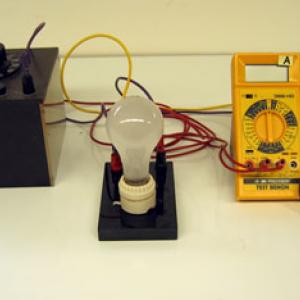College of Liberal Arts & Sciences
5D20.31 - Stefan's Law - Resistance of Light Bulbs
Plot current and voltage in 5 or 10 volt intervals from 0 to 120 volts. Plot this on a spread sheet along with the calculated value of the resistance. You should see a very dramatic rise in resistance as a function of current, which can be related to resistance as a function of temperature.
- C. I. Ribeiro, "Blackbody Radiation from an Incandescent Lamp", TPT, Vol. 52, # 6, Sept. 2014, p. 371.
- "Figuring Physics", TPT, Vol. 52, # 2, Feb. 2014, p. 120.
- Biswajit Ray, "Don't Zap That Light Bulb", TPT, Vol. 44, # 6, p. 374, Sept. 2006.
- Biman Das, "Obtaining Wien's Displacement Law from Planck's Law of Radiation", TPT, Vol. 40, # 3, Mar. 2002, p. 148 - 149.
- V. J. Menon and D. C. Agrawal, "Lifetimes of Incandescent Bulbs", TPT, Vol. 41, Feb. 2003, p. 100 - 101.
- Bruce Denardo, "Temperature of a Lightbulb Filament", TPT, Vol. 40, # 2, Feb. 2002, p. 101 - 105.
- Ernest Zebrowski, Jr., "The Lamp in the Laboratory", TPT, Vol. 38, # 4, Apr. 2000, p. 198.
- Mark P. Silverman and Christopher R. Silverman, "Cool in the Kitchen: Radiation, Conduction, and the Newton "Hot Block" Experiment", Vol. 38, # 2, Feb. 2000, p. 82 - 88.
- Dan Maclsaac, Gary Kanner, and Grayaon Anderson, "Basic Physics of the Incandescent Lamp (Lighbulb)", TPT, Vol. 37, # 9, Dec. 1999, p. 520 - 523.
- Steven A. Waltner and Thomas A. Lehman, "When is Ohm's Law Valid?", TPT, Vol. 31, # 2, Feb. 1993, p. 102 - 103.
- David G. Fisher, "Diode Characteristics to Determine Boltzmann Constant", TPT, Vol. 30, # 5, May 1992, p. 315 - 316.
- William S. Wagner, "Temperature and Color of Incandescent Lamps", TPT, Vol. 29, # 3, Mar. 1991, p. 176 - 177.
- Edward V. Lee, "Determination of Boltzmann's Constant", TPT, Vol. 13, # 5, May 1975, p. 305.
- B. S. N. Prasad and Rita Mascarenhas, "A Laboratory Experiment on the Application of Stefan's Law to Tungsten Filament Electric Lamps", AJP, Vol. 46, # 4, Apr. 1978, p. 420 - 423.
- D. H. Jaecks, R. Du Bois, "Stefan-Boltzmann and Radiation Distribution Laws in the Laboratory", AJP, Vol. 40, # 8, Aug. 1972, p. 1179 - 1180.
- J. Dryzek and K. Ruebenbauer, "Planck's Constant Determination from Black-Body Radiation", AJP, Vol. 60, # 3, Mar. 1992, p. 251 - 253.
- Vittorio Zanetti, "Temperature of Incadescent Lamps", AJP, Vol. 53, # 6, June 1985, p. 546 - 548.
- Arthur W. Knudsen, "Boltzmann Temperature: An Instructional Experiment for the Advanced Laboratory", AJP, Vol. 53, #5, May 1985, p. 409.
- R. E. Crandall and J. F. Delord, "Minimal Apparatus for Determination of Planck's Constant", AJP, Vol. 51, #1, Jan. 1983, p. 90.
- B. S. N. Prasad and Rita Mascarenhas, "A Laboratory Experiment on the Application of Stefan's Law to Tungsten Filament Electric Lamps", AJP, Vol. 46, #4, April 1978, p. 420.
- I. R. Edmonds, "Stephan-Boltzmann Law in the Laboratory", AJP, Vol. 36, #9, Sept. 1968, p. 845.
- "Lamp Resistance", Dick and Rae Physics Demo Notebook, 04-93.
- "Light Bulbs and Log-Log Plot", Dick and Rae Physics Demo Notebook, 03-93.
- Slavko Kocijancic and Colm O'Sullivan, "Are Dead Chickens Ohmic?", Physics Education, Vol. 39, # 1, Jan. 2004, p. 69 - 73.
- Yaakov Kraftmakher, "3.7, Thermal Noise", Experiments and Demonstrations in Physics, ISBN 981-256-602-3, p. 191.
- Yaakov Kraftmakher, "2.6, Light Bulb", Experiments and Demonstrations in Physics, ISBN 981-256-602-3, p. 108.
- W. T. Plummer, "Experiment B27. Stefan-Boltzmann Law", Laboratory of Astrophysics and Physical Meteorology, John Hopkins University, p. 246 - 250.
- John H. Moore, Christopher C. Davis, Michael A. Coplan, Sandra C. Greer, "Continuum Sources", Second Edition Building Scientific Apparatus, p. 196 - 198.
- Jearl Walker, "Simple and Vivid Demonstrations of Advanced Concepts in Physics", The Amateur Scientist, 1983.
Disclaimer: These demonstrations are provided only for illustrative use by persons affiliated with The University of Iowa and only under the direction of a trained instructor or physicist. The University of Iowa is not responsible for demonstrations performed by those using their own equipment or who choose to use this reference material for their own purpose. The demonstrations included here are within the public domain and can be found in materials contained in libraries, bookstores, and through electronic sources. Performing all or any portion of any of these demonstrations, with or without revisions not depicted here entails inherent risks. These risks include, without limitation, bodily injury (and possibly death), including risks to health that may be temporary or permanent and that may exacerbate a pre-existing medical condition; and property loss or damage. Anyone performing any part of these demonstrations, even with revisions, knowingly and voluntarily assumes all risks associated with them.
